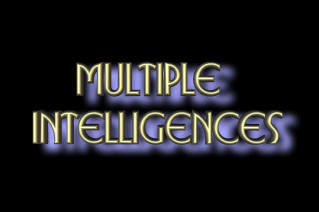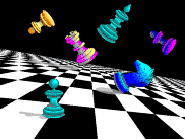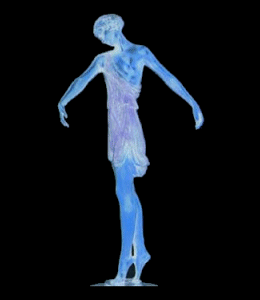
INTRODUCTION
Howard Gardner, a professor at Harvard University, hypothesizes that people are capable of seven unique ways of information processing. Information processing is the person's preferred intellectual approach to assimilating facts, information, and knowledge.
Gardner suggests that individuals should be encouraged to apply their preferred intelligences in learning. Learners who have an understanding of their own particular learning styles can reflect on how to utilize their learning strengths and cultivate their less dominant ones. A key point in multiple intelligence theory is that most people can develop all seven of the intelligences to a relatively competent level of mastery. The Essence of the IntelligencesLinguistic-Verbal Intelligence
This intelligence is our capacity to use words effectively, both orally and in writing, as a vehicle of expression and communication. It is also our ability to learn from reading the printed word, and listening to others convey information through speaking. Linguistic intelligence includes the ability to manipulate the syntax and structure
of language, such as:
People with well developed linguistic intelligence find their fullest identity in writing or in verbal storytelling. They are articulate, accurate spellers, and avid readers. They often think in words, and learn well by listening to others speak, by reading, writing, and verbalizing. They love to play with language, are good at remembering names, places, dates, and trivia. If these people are given the opportunity to hear, see, and say words associated with the desired outcome, they will readily learn practically anything of interest to them. Logical-Mathematical Intelligence
This intelligence is our capacity to think logically, to use numbers effectively, to solve problems scientifically, and to discern relationships and patterns between concepts and objects. We use this intelligence when we engage in activities such as making lists, setting priorities, and making future plans.
People with well developed logical mathematical intelligence are sensitive to logical patterns and relationships, to functions, propositions, and hypotheses. They can easily use categorization, classification, inference, generalization, and calculation. They are "natural" critical thinkers, and adeptly handle long chains of reasoning. These individuals learn best when provided with opportunities to classify, categorize, and work with abstractions and to experiment. They like to figure things out by asking questions, exploring and finding the order and logic in the content to be learned. They are usually good at math and in logical problem-solving. Visual-Spatial Intelligence
This intelligence is our ability to think visually and orient ourselves spatially - our ability to perceive the visual - spatial world accurately. This includes our sensitivity to colour, line, shape, form, space and the relationships between these. It is our capacity to "see" and to graphically represent visual and spatial ideas. It is our appreciation and recognition of how a selected object would look from another viewing angle, for instance, if turned around.
People with well developed spatial- visual intelligence enjoy drawing, designing, looking at pictures and images, slides, videos, and films. They are especially proficient at imagining, visualization, sensing changes, doing puzzles, and reading charts and maps. They absorb information best through visualizing, using the "mind's eye", and by manipulating and working with pictures and images. This intelligence can serve a variety of scientific ends; as a useful tool, as an aid to thinking, as a way of capturing information, and a way to formulate and solve problems, and graphically represent patterns. Bodily-Kinesthetic Intelligence
This intelligence is our capacity to use our bodies in highly differentiated and skilled ways, for expression as well as for goal - directed purposes. It includes our fine and gross motor movements, sense of timing, and direction. It is also our physical coordination, balance, dexterity, strength, speed, flexibility, and proprioceptive, tactile, and haptic capacities.
People with well developed bodily - kinesthetic intelligence process knowledge through their bodily sensations and learn best by touching, manipulating, and moving. They often have a natural sense of how their body should act and react in demanding physical situations. Learning is best facilitated by providing a kinetic component, where the learner can interact with space in some way to help them process and remember the new information through their body. Musical Intelligence
This intelligence is our capacity to perceive, discriminate, transform, and express musical forms. This includes our sensitivity to rhythm, pitch, melody, timbre, and tone colour. It is our capacity to appreciate a variety of musical forms as well as using music as a vehicle of expression. This intelligence is active when we use tones and rhythmic patterns (either instrumental, environmental, and/or human - made) to communicate how we are feeling and what we believe (for instance, intense joy, fear, excitement).
People with well developed musical intelligence excel at remembering melody, noticing the rhythms of life, and usually keep perfect time. They are hummers of tunes, singers of songs, probably play an instrument, and often listen to music. These learners get new information by listening to melodies, writing musical notations, or in using rhythm to help them master new concepts. They are able to hear music and rhythm accurately, to remember, master, and eventually produce musical sequences. Intrapersonal Intelligence
This intelligence allows us to tap our inner being - to discover who we are, what feelings we have, and why we are the way the way we are. It represents our self - knowledge and our ability to act adaptively on the basis of this knowledge. It is our reflective self. People with well - developed intrapersonal intelligence have an accurate picture of their inner self - their strengths and weaknesses, their inner moods, goals, intentions, motivations, temperament, beliefs, and desires. They have the capacity to cultivate superb self - discipline, self - understanding, and high self - esteem.
They seem to be self - motivating, need their own quiet space to work in, and "march to the beat of a different drummer". These learners take in knowledge more easily through independent study and self - paced instruction. They absorb new information best when involved in individual projects. Interpersonal Intelligence
This intelligence is our capacity to interact with others, to understand them, and to interpret their behaviour accurately. It is our ability to notice distinctions among other people, and to recognize their moods, temperaments, motivations, and intentions. It is our sensitivity to other's facial expressions, voices, and gestures, and our ability to respond effectively to these cues. It is our capacity to appropriately and effectively respond to other people and to understand them.
People with well developed interpersonal intelligence have a strong sense of empathy and concern for others. They are often natural leaders, and take others "under their wing". They are almost always with a group of people and have a wide circle of friends and acquaintances. They like to talk with others, to teach others, and to organize, mediate and communicate in group activities. They generally understand people and instinctively know how to work with them. They learn best when given the opportunity to interview others, share ideas, and to cooperate and collaborate to complete any task.
Purchase my Easy to Use E-Manual for testing and exploring your Multiple Intelligences.
All rights reserved 1998 - 2004
|